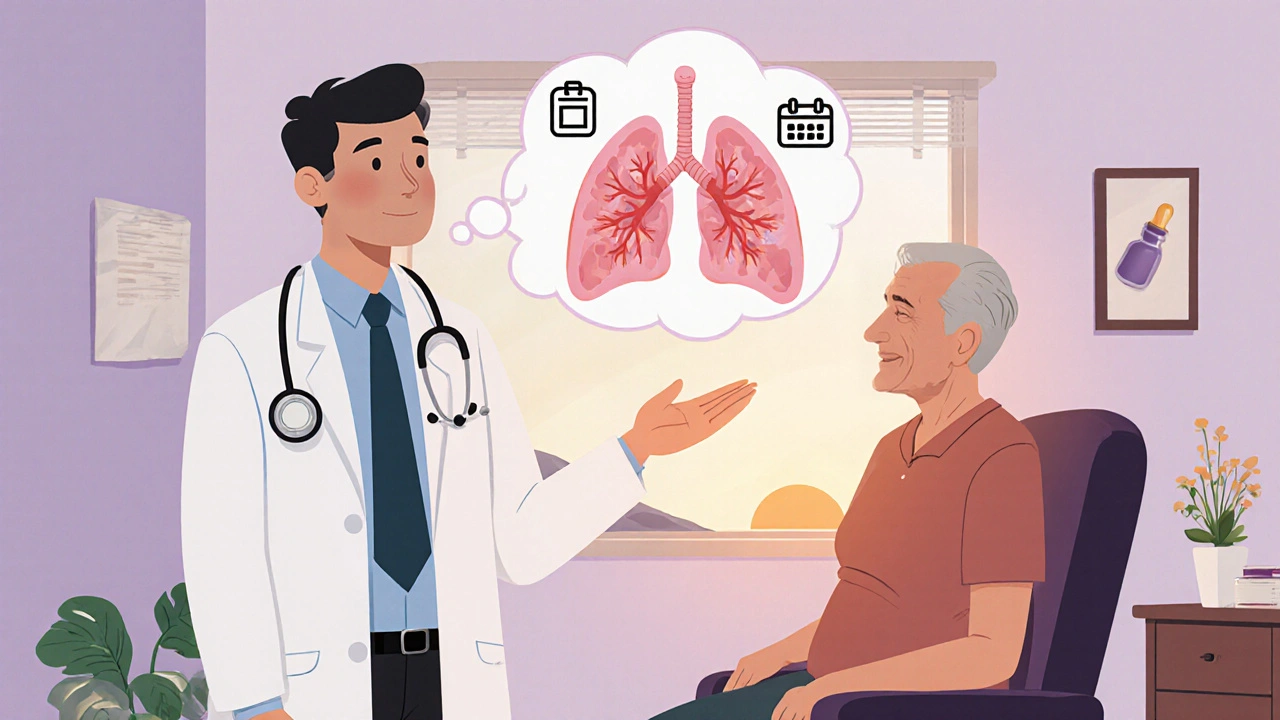Esbriet (Pirfenidone) – Your Guide to the Antifibrotic Lung Medicine
When talking about Esbriet, the branded form of pirfenidone used to slow the progression of idiopathic pulmonary fibrosis (IPF), also known as pirfenidone, you’re dealing with a drug that targets scar tissue in the lungs. In plain terms, Esbriet aims to keep the lungs from stiffening so breathing stays easier for longer. It’s a prescription‑only medication, so you’ll need a doctor’s okay before you can start.
Esbriet sits inside a broader class of antifibrotic therapies, treatments that interfere with the body’s fibrotic response and help preserve organ function. The most common condition they address is idiopathic pulmonary fibrosis, a chronic, progressive lung disease marked by scarring of the alveolar tissue. While the disease is rare, its impact is huge: shortness of breath, reduced exercise tolerance, and a higher risk of respiratory failure. By reducing fibroblast activity, Esbriet helps slow the decline in lung function measured by forced vital capacity (FVC). In practice, patients often pair the drug with regular lung function monitoring, spirometry tests that track changes in breathing capacity over time to gauge how well the therapy works.
What matters most when you start Esbriet
First off, dosage matters. The standard regimen ramps up over two weeks to reach the target 801 mg three times daily. Skipping doses or stopping abruptly can cause a rebound in fibrosis activity, so you’ll want a clear plan with your clinician. Second, side‑effects are a real part of the picture. The most reported are photosensitivity (sunburn‑like reactions), nausea, loss of appetite, and a distinct taste disturbance. Wearing sunscreen, taking the pill with food, and staying hydrated can blunt many of these complaints. Third, drug interactions can change how Esbriet works or increase toxicity. For instance, strong CYP1A2 inhibitors such as fluvoxamine can raise pirfenidone levels, while smoking can lower them. Your doctor will likely run a medication review—something we’ve covered in depth in articles about drug‑interaction monitoring and respiratory health.
Because Esbriet affects the liver, regular liver‑function tests are part of the safety net. If enzymes rise, the dose may need adjustment or a temporary pause. This monitoring mirrors what we discuss in pieces about atazanavir’s pulmonary risks and losartan’s safety profile—both highlight the importance of labs when managing chronic meds. Additionally, patients with pre‑existing gastro‑intestinal issues should discuss prophylactic strategies, as the pill can irritate the stomach lining. Some clinicians recommend a proton‑pump inhibitor; we’ve compared generic Prilosec options in a separate guide.
From a broader perspective, Esbriet is one piece of a multidisciplinary approach to IPF. Pulmonologists often combine it with oxygen therapy, pulmonary rehabilitation, and lifestyle tweaks like quitting smoking and staying active. The disease’s emotional toll is also notable; anxiety and depression rates are higher in IPF cohorts, echoing our coverage of how chronic conditions such as osteoporosis can affect mental health. Addressing mental wellbeing—through counseling or support groups—can improve adherence to the medication schedule.
If you’re curious about how Esbriet stacks up against other antifibrotics, nintedanib (Ofev) is the main alternative. Both drugs slow disease progression, but they differ in side‑effect profiles: nintedanib leans toward diarrhea, while Esbriet leans toward photosensitivity. Choosing between them depends on individual tolerance, comorbidities, and personal preferences. This decision‑making process mirrors the comparative reviews we publish for Losartan versus other blood‑pressure agents or Abilify versus its generics.
Insurance coverage can be a hurdle. Many health plans require prior authorization, and the out‑of‑pocket cost can be high without assistance programs. We’ve outlined how to navigate cheap generic purchases for other drugs, and similar strategies apply here: look for patient‑assistance programs directly from the manufacturer or explore reputable online pharmacies that verify legitimacy.
Finally, staying informed about the latest research matters. Clinical trials are testing combination antifibrotic regimens, and new biomarkers are emerging to predict who benefits most from Esbriet. Keeping an eye on the latest FDA updates or conference highlights can help you and your provider fine‑tune therapy. Our coverage of targeted therapies in leukemia and immunotherapy breakthroughs shows how rapidly treatment landscapes evolve, and the same pace applies to IPF.
All of these points—dosage, side‑effects, monitoring, interactions, mental health, alternatives, cost, and emerging research—paint a full picture of what living with Esbriet looks like. Below you’ll find a curated selection of articles that dig deeper into each of these areas, from practical tips on managing drug‑induced photosensitivity to step‑by‑step guides on interpreting lung‑function tests. Explore the list to find actionable insights that match your stage of treatment, whether you’re just starting the medication or looking to optimize long‑term care.
Esbriet (Pirfenidone) vs Other IPF Drugs: Full Comparison Guide
A detailed comparison of Esbriet (pirfenidone) with nintedanib and other IPF treatments, covering efficacy, side effects, dosing, cost and practical tips.
Read more
